The global surface protection film market is valued at USD 1.4 billion in 2025 and is slated to reach USD 2.7 billion by 2035, recording an absolute increase of USD 1.3 billion over the forecast period. This translates into a total growth of 92.9%, with the market forecast to expand at a compound annual growth rate (CAGR) of 6.8% between 2025 and 2035. The overall market size is expected to grow by nearly 1.93X during the same period, supported by increasing demand for protective solutions in electronics manufacturing, growing adoption of advanced adhesive technologies in automotive applications, and rising preference for temporary protection systems across construction, aerospace, and industrial manufacturing sectors.
Between 2025 and 2030, the surface protection film market is projected to expand from USD 1.4 billion to USD 2.0 billion, resulting in a value increase of USD 0.6 billion, which represents 46.2% of the total forecast growth for the decade. This phase of development will be shaped by increasing electronics production requiring precision surface protection systems, rising adoption of removable adhesive technologies, and growing demand for films with enhanced clarity and residue-free removal properties. Electronics manufacturers are expanding their surface protection film sourcing capabilities to address the growing demand for display protection, component handling, and high-precision assembly line requirements.
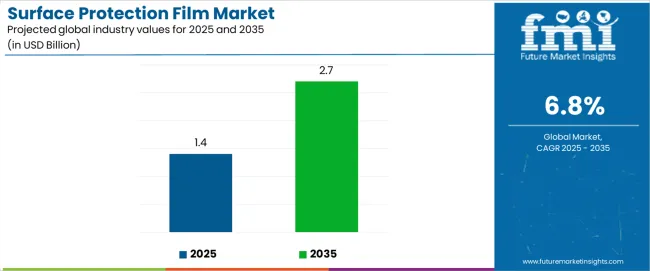
| Metric | Value |
|---|---|
| Estimated Value in (2025E) | USD 1.4 billion |
| Forecast Value in (2035F) | USD 2.7 billion |
| Forecast CAGR (2025 to 2035) | 6.8% |
From 2030 to 2035, the market is forecast to grow from USD 2.0 billion to USD 2.7 billion, adding another USD 0.7 billion, which constitutes 53.8% of the overall ten-year expansion. This period is expected to be characterized by the expansion of nano-coating integration for enhanced protection properties, the incorporation of smart indicator technologies for application monitoring, and the development of bio-based film materials with reduced environmental impact. The growing adoption of advanced manufacturing principles will drive demand for surface protection films with superior conformability features and compatibility with automated application systems across production facilities.
Between 2020 and 2025, the surface protection film market experienced robust growth, driven by increasing demand for temporary protection solutions in electronics manufacturing and growing recognition of surface protection films as essential components for maintaining product quality during processing, transportation, and installation across automotive, construction, and industrial applications. The market developed as manufacturers recognized the potential for protection films to provide superior surface integrity while enabling efficient removal processes and cost-effective damage prevention strategies. Technological advancement in adhesive formulation and film substrate development began emphasizing the critical importance of maintaining adhesion performance and clean removal characteristics in diverse application environments.
Market expansion is being supported by the increasing global demand for high-quality surface finishes and the corresponding need for protection systems that can provide superior damage prevention and removal convenience while enabling flexible application methods and cost reduction across various electronics, automotive, and construction manufacturing applications. Modern electronics assembly facilities and automotive manufacturers are increasingly focused on implementing protection solutions that can optimize surface quality, reduce defect rates, and provide consistent performance throughout complex production operations. Surface protection film technology's proven ability to deliver exceptional adhesion control, enable clean removal properties, and support automated application make them essential materials for contemporary manufacturing and assembly operations.
The growing emphasis on quality control and defect prevention is driving demand for surface protection films that can support high-performance requirements, improve surface integrity, and enable advanced application systems. Manufacturers' preference for materials that combine effective protection with reduced contamination risk and processing efficiency is creating opportunities for innovative film implementations. The rising influence of premium product markets and aesthetic quality requirements is also contributing to increased demand for surface protection films that can provide invisible protection, handling durability, and pristine surface presentation across diverse product categories.
The surface protection film market is poised for rapid growth and transformation. As industries across electronics, automotive, construction materials, and industrial manufacturing seek materials that deliver exceptional protection performance, application versatility, and removal reliability, surface protection films are gaining prominence not just as protective materials but as strategic enablers of quality assurance and manufacturing efficiency.
Rising electronics production in Asia-Pacific and expanding automotive markets globally amplify demand, while manufacturers are leveraging innovations in adhesive chemistry, film engineering, and automated application systems.
Pathways like advanced adhesive formulations, intelligent application monitoring, and specialty film configurations promise strong margin uplift, especially in high-value segments. Geographic expansion and technology partnerships will capture volume, particularly where local manufacturing capabilities and electronics industry proximity are critical. Regulatory pressures around product quality standards, manufacturing cleanliness requirements, production efficiency guidelines, and waste reduction specifications give structural support.
The market is segmented by film type, adhesive technology, thickness range, application method, end-use industry, performance characteristics, and region. By film type, the market is divided into polyethylene films, polyurethane films, and multi-layer composite films. By adhesive technology, it covers acrylic adhesives, rubber-based adhesives, and silicone adhesives. By thickness range, it includes ultra-thin (below 50 microns), standard (50-150 microns), and heavy-duty (above 150 microns) films. By application method, it covers manual application, automated dispensing, and pre-applied systems. By end-use industry, it is categorized into electronics & electrical, automotive & transportation, construction & building materials, aerospace & defense, and industrial manufacturing. By performance characteristics, it covers temporary protection, long-term protection, and specialty performance films. Regionally, the market is divided into North America, Europe, East Asia, South Asia & Pacific, Latin America, and the Middle East & Africa.
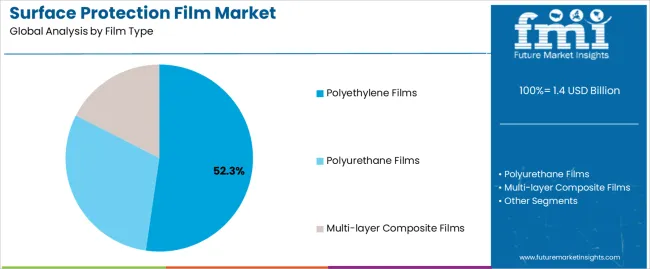
The polyethylene films segment is projected to account for 52.3% of the surface protection film market in 2025, reaffirming its position as the leading film type category. Electronics producers and automotive manufacturers increasingly utilize polyethylene protection films for their optimal cost-effectiveness, excellent conformability characteristics, and widespread adoption in display protection, painted surface covering, and general manufacturing applications. The polyethylene film technology's established industry acceptance and consistent performance properties directly address the industrial requirements for reliable temporary protection in high-volume production environments.
This film type segment forms the foundation of modern surface protection operations, as it represents the protection technology with the greatest market penetration and established demand across multiple industrial categories and global markets. Manufacturer investments in enhanced adhesive compatibility and improved optical clarity continue to strengthen adoption among electronics producers and automotive manufacturers. With companies prioritizing cost efficiency and application versatility, polyethylene films align with both performance requirements and economic objectives, making them the central component of comprehensive surface protection strategies.
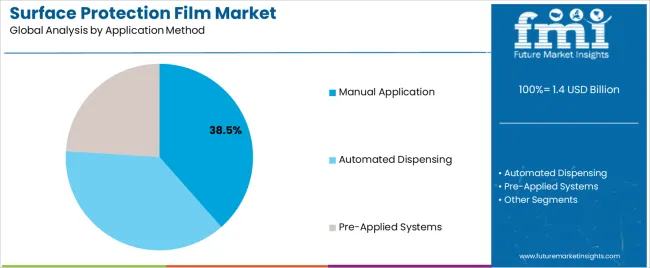
Electronics & electrical applications are projected to represent 38.5% of surface protection film demand in 2025, underscoring their critical role as the primary industrial consumers of protection films for display manufacturing, component assembly, and electronic device production. Electronics manufacturers prefer surface protection films for their exceptional optical clarity, superior adhesion control, and ability to accommodate precise application requirements while ensuring residue-free removal with maintained surface integrity. Positioned as essential materials for modern electronics assembly and semiconductor fabrication operations, surface protection films offer both quality assurance and manufacturing efficiency benefits.
The segment is supported by continuous innovation in adhesive chemistry and the growing availability of specialized film formulations that enable precision application with enhanced clarity and clean removal properties. Additionally, electronics producers are investing in automated application systems to support large-volume surface protection film utilization and quality consistency. As electronics production becomes more sophisticated and display quality requirements increase, electronics & electrical applications will continue to dominate the end-use market while supporting advanced automation integration and quality optimization strategies.
The surface protection film market is advancing rapidly due to increasing demand for quality protection solutions in electronics manufacturing and growing adoption of advanced adhesive systems that provide superior performance reliability and removal convenience while enabling cost reduction across diverse electronics, automotive, and industrial manufacturing applications. However, the market faces challenges, including fluctuating raw material costs, competition from alternative protection methods, and the need for specialized application expertise for optimal performance. Innovation in adhesive chemistry and film engineering continues to influence product development and market expansion patterns.
The growing adoption of temperature-controlled adhesives, UV-removable systems, and intelligent bonding technologies is enabling manufacturers to produce surface protection films with superior application control, enhanced removal efficiency, and multi-environment performance functionalities. Advanced adhesive systems provide improved versatility while allowing more efficient specialized applications and consistent quality across various protection requirements and substrate configurations. Manufacturers are increasingly recognizing the competitive advantages of adhesive innovation for application flexibility and performance reliability.
Modern surface protection film producers are incorporating anti-reflective coatings, optical clarity enhancement, and light transmission optimization to deliver superior visual performance, enable production monitoring, and provide value-added aesthetic solutions to electronics brands and automotive customers. These technologies improve application versatility while enabling new operational capabilities, including quality inspection, automated verification, and production analytics. Advanced optical integration also allows manufacturers to support high-end applications and premium product requirements beyond traditional protection approaches.
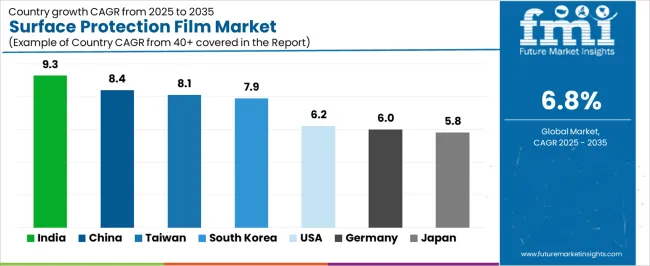
| Country | CAGR (2025-2035) |
|---|---|
| China | 8.4% |
| South Korea | 7.9% |
| USA | 6.2% |
| Japan | 5.8% |
| Germany | 6.0% |
| Taiwan | 8.1% |
| India | 9.3% |
The surface protection film market is experiencing strong growth globally, with India leading at a 9.3% CAGR through 2035, driven by the expanding electronics manufacturing sector, growing automotive production, and significant investment in industrial infrastructure development. China follows at 8.4%, supported by massive electronics production capacity, increasing smartphone manufacturing, and growing export packaging demand. South Korea shows growth at 7.9%, emphasizing advanced semiconductor manufacturing and display technology development. Taiwan records 8.1%, focusing on precision electronics production and high-tech manufacturing. The USA demonstrates 6.2% growth, prioritizing advanced materials innovation and aerospace applications. Germany exhibits 6.0% growth, emphasizing precision engineering and automotive industry excellence. Japan shows 5.8% growth, focusing on quality control and advanced manufacturing systems.
The report covers an in-depth analysis of 40+ countries top-performing countries are highlighted below.
Revenue from surface protection films in India is projected to exhibit exceptional growth with a CAGR of 9.3% through 2035, driven by expanding electronics production and rapidly growing smartphone manufacturing supported by government initiatives promoting domestic production capabilities. The country's strong position in electronics assembly and increasing investment in manufacturing infrastructure are creating substantial demand for surface protection film solutions. Major electronics producers and automotive manufacturers are establishing comprehensive material sourcing capabilities to serve both domestic production demand and export manufacturing markets.
Revenue from surface protection films in China is expanding at a CAGR of 8.4%, supported by the country's massive electronics manufacturing sector, expanding automotive production activities, and increasing adoption of quality control solutions. The country's government initiatives promoting manufacturing excellence and growing export production are driving requirements for advanced protection capabilities. International suppliers and domestic manufacturers are establishing extensive production and distribution capabilities to address the growing demand for surface protection film products.
Revenue from surface protection films in the USA is expanding at a CAGR of 6.2%, supported by the country's advanced materials sector, strong emphasis on aerospace applications, and robust demand for high-performance materials in electronics and automotive manufacturing applications. The nation's innovative industrial sector and technology-focused operations are driving sophisticated protection systems throughout the supply chain. Leading manufacturers and technology providers are investing extensively in adhesive chemistry and film engineering to serve both domestic and international markets.
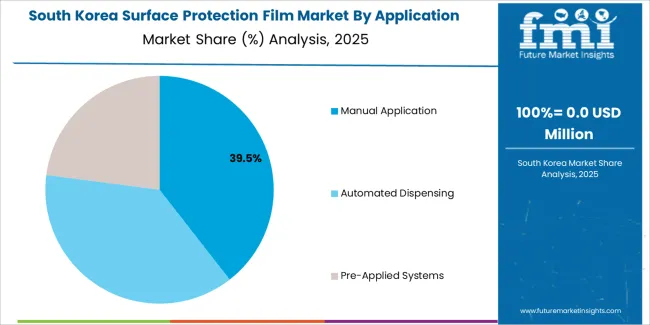
Revenue from surface protection films in South Korea is growing at a CAGR of 7.9%, driven by the country's leading semiconductor industry, advanced display manufacturing, and increasing investment in precision electronics production facilities. South Korea's technology leadership and commitment to manufacturing innovation are supporting demand for surface protection film solutions across multiple high-tech segments. Manufacturers are establishing comprehensive production capabilities to serve the growing domestic market and global technology export opportunities.
Revenue from surface protection films in Germany is expanding at a CAGR of 6.0%, supported by the country's automotive industry leadership, advanced manufacturing capabilities, and strategic focus on high-quality production materials. Germany's engineering excellence and precision focus are driving demand for surface protection films in automotive production, industrial manufacturing, and aerospace applications. Manufacturers are investing in comprehensive material capabilities to serve both domestic producers and international premium markets.
Revenue from surface protection films in Taiwan is growing at a CAGR of 8.1%, driven by the country's expertise in electronics manufacturing, emphasis on semiconductor production, and strong position in precision technology applications. Taiwan's established technology capabilities and commitment to quality are supporting investment in advanced materials throughout major manufacturing centers. Industry leaders are establishing comprehensive material systems to serve domestic electronics producers and global technology manufacturers.
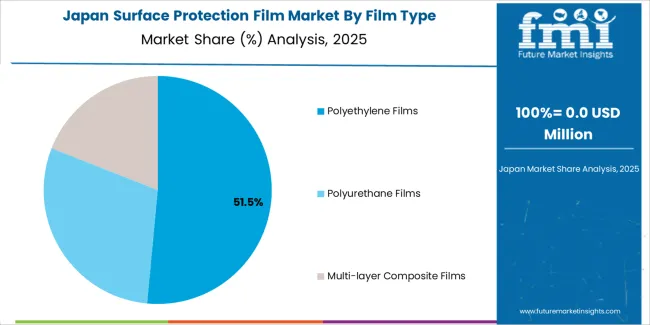
Revenue from surface protection films in Japan is expanding at a CAGR of 5.8%, supported by the country's quality manufacturing tradition, advanced materials innovation, and strategic position in electronics and automotive production. Japan's precision manufacturing capabilities and integrated production infrastructure are driving demand for high-quality surface protection films in electronics assembly, automotive manufacturing, and industrial applications. Leading manufacturers are investing in specialized capabilities to serve the requirements of diverse technology and manufacturing industries.
The surface protection film market in Europe is projected to grow from USD 0.35 billion in 2025 to USD 0.68 billion by 2035, registering a CAGR of 6.9% over the forecast period. Germany is expected to maintain its leadership position with a 34.7% market share in 2025, declining slightly to 34.2% by 2035, supported by its strong automotive industry base, advanced manufacturing capabilities, and comprehensive electronics production sector serving diverse surface protection applications across Europe.
France follows with a 19.2% share in 2025, projected to reach 19.6% by 2035, driven by robust demand for surface protection films in automotive production, aerospace applications, and electronics manufacturing, combined with established industrial infrastructure and technology-oriented production expertise. Italy holds a 16.4% share in 2025, expected to reach 16.8% by 2035, supported by strong automotive component manufacturing and growing electronics assembly adoption. The United Kingdom commands a 14.8% share in 2025, projected to reach 15.1% by 2035, while Spain accounts for 8.1% in 2025, expected to reach 8.3% by 2035. Netherlands maintains a 3.7% share in 2025, growing to 3.8% by 2035. The Rest of Europe region, including Nordic countries, Eastern Europe, Belgium, Switzerland, and other nations, is anticipated to maintain momentum, with its collective share moving from 3.1% to 2.2% by 2035, attributed to increasing electronics production in Eastern Europe and growing automotive manufacturing in Nordic countries implementing advanced protection programs.
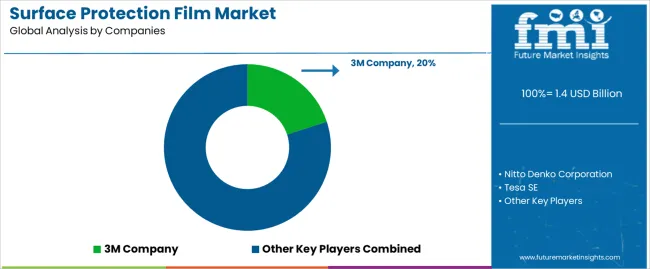
The surface protection film market is characterized by competition among established adhesive technology companies, specialized film manufacturers, and integrated materials solutions providers. Companies are investing in adhesive chemistry research, film substrate optimization, application technology development, and comprehensive product portfolios to deliver consistent, high-performance, and application-specific surface protection film solutions. Innovation in removal systems, optical properties, and automation compatibility is central to strengthening market position and competitive advantage.
3M Company leads the market with20% share, offering comprehensive surface protection film solutions with a focus on electronics and automotive applications. Nitto Denko Corporation provides specialized adhesive technology capabilities with an emphasis on precision applications and advanced bonding systems. Tesa SE delivers innovative protection products with a focus on automotive applications and industrial manufacturing. LINTEC Corporation specializes in optical films and display protection solutions for electronics applications. Avery Dennison Corporation focuses on adhesive materials and application systems with integrated production solutions. Saint-Gobain Performance Plastics offers specialized films for aerospace and industrial applications with emphasis on high-performance requirements.
| Items | Values |
|---|---|
| Quantitative Units (2025) | USD 1.4 billion |
| Film Type | Polyethylene Films, Polyurethane Films, Multi-layer Composite Films |
| Adhesive Technology | Acrylic Adhesives, Rubber-Based Adhesives, Silicone Adhesives |
| Thickness Range | Ultra-Thin (below 50 microns), Standard (50-150 microns), Heavy-Duty (above 150 microns) |
| Application Method | Manual Application, Automated Dispensing, Pre-Applied Systems |
| End-Use Industry | Electronics & Electrical, Automotive & Transportation, Construction & Building Materials, Aerospace & Defense, Industrial Manufacturing |
| Performance Characteristics | Temporary Protection, Long-Term Protection, Specialty Performance Films |
| Regions Covered | North America, Europe, East Asia, South Asia & Pacific, Latin America, Middle East & Africa |
| Countries Covered | United States, Canada, United Kingdom, Germany, France, Italy, China, Japan, South Korea, India, Taiwan, Australia and 40+ countries |
| Key Companies Profiled | 3M Company, Nitto Denko Corporation, Tesa SE, Avery Dennison Corporation, LINTEC Corporation, and Saint-Gobain Performance Plastics |
| Additional Attributes | Dollar sales by film type and application category, regional demand trends, competitive landscape, technological advancements in adhesive chemistry, optical enhancement development, automated application innovation, and quality monitoring connectivity |
The global surface protection film market is estimated to be valued at USD 1.4 billion in 2025.
The market size for the surface protection film market is projected to reach USD 2.7 billion by 2035.
The surface protection film market is expected to grow at a 6.8% CAGR between 2025 and 2035.
The key product types in surface protection film market are polyethylene films, polyurethane films and multi-layer composite films.
In terms of application method, manual application segment to command 38.5% share in the surface protection film market in 2025.






Full Research Suite comprises of:
Market outlook & trends analysis
Interviews & case studies
Strategic recommendations
Vendor profiles & capabilities analysis
5-year forecasts
8 regions and 60+ country-level data splits
Market segment data splits
12 months of continuous data updates
DELIVERED AS:
PDF EXCEL ONLINE
Surface Treatment Chemicals Market Size and Share Forecast Outlook 2025 to 2035
Surface Mounting Distribution Panel Market Size and Share Forecast Outlook 2025 to 2035
Surface Mounted Medium Voltage Distribution Panel Market Size and Share Forecast Outlook 2025 to 2035
Surface Radars Market Size and Share Forecast Outlook 2025 to 2035
Surface Mining Market Size and Share Forecast Outlook 2025 to 2035
Surface Mount Technology Market Size and Share Forecast Outlook 2025 to 2035
Surface Levelling Equipment Market Size and Share Forecast Outlook 2025 to 2035
Surface Mining Equipment Market Size and Share Forecast Outlook 2025 to 2035
Surface Disinfectant Chemicals Market Growth & Demand 2025 to 2035
Surface Disinfectant Market is segmented by product type, form and end user from 2025 to 2035
Surface Disinfectant Products Market Growth - Trends and Forecast 2025 to 2035
Surface Water Sports Equipment Market Growth – Size, Trends & Forecast 2024-2034
Surface Plasmon Resonance System Market Analysis – Growth & Forecast 2024-2034
Surface Measurement Equipment And Tools Market
Surface Drilling Rigs Market
Surface printed Film Market Size and Share Forecast Outlook 2025 to 2035
Competitive Overview of Surface Printed Film Companies
Surface Protection Service Market Size and Share Forecast Outlook 2025 to 2035
Cell Surface Markers Detection Market Size and Share Forecast Outlook 2025 to 2035
Hard Surface Flooring Market Size and Share Forecast Outlook 2025 to 2035

Thank you!
You will receive an email from our Business Development Manager. Please be sure to check your SPAM/JUNK folder too.
Chat With
MaRIA